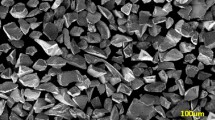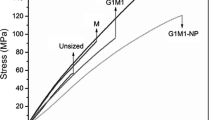Abstract
The influence that the energy absorbing ability of an epoxy has on the cyclic fatigue resistance of a silane-bonded epoxy/glass interface in moist air was studied using the double cleavage drilled compression (DCDC) test. The material properties of two epoxies with similar chemical structures were controlled through the manipulation of the molecular weight between cross-links, M c, of the epoxy network. Two rubber-toughened epoxies with different nominal particle sizes (10–40 μm and 1–2 μm) were fabricated by adding a liquid butadiene/acrylonitrile copolymer to the epoxy resins. Mixtures of the silane-coupling agents 3-aminopropyltriethoxysilane (3-APES) and propyltriethoxysilane (PES) were used to treat the glass substrate in order to control the number of covalent bonds between epoxy and the glass. 3-APES has the ability to form primary bonds with both the epoxy and the glass, while PES forms primary bonds with only the glass. Experimental results showed that the manipulation of M c had little effect on the cyclic fatigue resistance of the epoxy/glass interface. However, incorporation of rubber particles gave a significant improvement in the fatigue resistance. The rubber particles allowed the microscopic, non-linear deformation mechanisms of cavitation and shear yielding to dissipate energy during fatigue crack growth. Smaller particles gave the greatest improvement to fatigue resistance; about a 75% improvement compared to the neat (non-modified) epoxy. Adjustment of the number of silane bonds between the neat epoxies and the glass had little effect within experimental scatter on the fatigue resistance of the interfaces, suggesting that the energy dissipated through the breaking of bonds at the interface was insignificant compared to the energy dissipated through plastic and other inelastic deformation mechanisms in the epoxy.
Similar content being viewed by others
References
A. BAGCHI and A. G. EVANS, Interface Science 3 (1996) 169.
J. W. SMITH, E. J. KRAMER and P. J. MILLS, J. Polym. Sci (Polym. Phys.) 32 (1994) 1731.
J. W. SMITH, E. J. KRAMER, FEI XIAO and CHUNGYUEN HUI, J. Mater. Sci. 28 (1993) 4234.
A. F. YEE and R. A. PEARSON, ibid. 21 (1986) 2462.
R. A. PEARSON and A. F. YEE, ibid. 21 (1986) 2475.
Idem., ibid. 24 (1989) 2571.
Idem., ibid. 26 (1991) 3838.
H. R. AZIMI, R. A. PEARSON and R. W. HERTZBERG, ibid. 31 (1996) 3777.
J. E. RITTER, J. R. FOX, D. I. HUTKO and T. J. LARDNER, ibid. 33 (1998) 4581.
J. E. RITTER, J. C. LEARNED, G. S. J ÁCOME, T. P. RUSSELL and T. J. LARDNER, in “Materials Reliability in Microelectronics IX,” edited by C. S. Volkert, A. H. Verbruggen and D. D. Brown, Mater. Res. Soc. Proc. (Pittsburgh, PA, 1999). 563 p. 291.
Idem., J. Adhesion 76 (2001) 401.
J. E. RITTER, G. S. JÁCOME, J. R. PELCH, T.P. RUSSELL and T. J. LARDNER, J. Electronic Packaging,to be published 2002.
E. CRAWFORD and A. J. LESSER, Pol. Engng. Sci. 39 (1999) 385.
Idem., J. Polym. Sci. (Polym. Phys.) 36 (1998) 1371.
M. Y. HE, M. R. TURNER and A. G. EVANS, Acta Met. Mater. 43 (1995) 3453.
Z. SUO and J. W. HUTCHINSON, Mater. Sci. Eng. A 107 (1989) 135.
A. G. EVANS, M. RUHLE, B. J. DALGLEISH and P. G. CHARALAMBIDES, Mater. Sci. and Eng. A 136 (1990) 53.
S. S. CHAKRAVARTHY, M. S. thesis, Mechanical and Industrial Engineering Department, University of Massachusetts, 2000.
Author information
Authors and Affiliations
Rights and permissions
About this article
Cite this article
Pelch, J.R., Ritter, J.E., Lesser, A.J. et al. Fatigue resistance of silane-bonded epoxy/glass interfaces using neat and rubber-toughened epoxies. Journal of Materials Science 37, 3269–3276 (2002). https://doi.org/10.1023/A:1016139218454
Issue Date:
DOI: https://doi.org/10.1023/A:1016139218454




